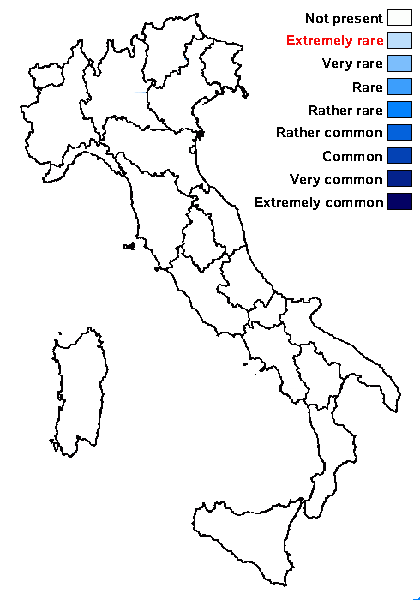Thamnolia vermicularis subsp. taurica (Wulfen) P. M. Jørg.
Lichenologist, 51: 225, 2019. Basionym: Lichen tauricus Wulfen - in Jacquin: Collect. Bot. II: 177, 1789.
Synonyms: Cenomyce taurica (Wulfen) Röhl; Cladonia taurica (Wulfen) Hoffm.; Thamnolia taurica (Wulfen) A. Massal.
Distribution:
Description: Thallus fruticose, pure white, becoming pinkish in the herbarium and staining the herbarium paper, erect or decumbent, often forming tufts. Thallus units 1-2(-3) mm thick (rarely to 8 mm), simple or rarely sparingly branched in upper part, worm-like, usually to 5 (rarely to 10) cm tall, more or less cylindrical, with pointed apices, the surface smooth, non squamulose. Cortex of longitudinally arranged hyphae; medulla thin, soon becoming hollow. Apothecia not known. Pycnidia poorly evident, immersed, initially covered by cortical tissue, flask-shaped to broadly globose, the wall colourless throughout, uni- or rarely bilocular, densely filled with long, parallel conidiophores comprising erect chains of intercalary conidiogenous cells with bayonet-like processes near the upper cell septum. Conidia bacilliform, slightly tapering at one end, 3-5 x 1-2 µm. Photobiont chlorococcoid. Spot tests: K+ bright yellow, C-, KC-, P+ orange, UV-. Chemistry: thamnolic acid.Note: a cryptic taxon with the thamnolic acid syndrome, known from the Eastern Alps (Austria), the Tatra Mnts. and the Carpathians. Italian material of Th. vermicularis subsp. vermicularis (with thamnolic acid) should be molecularly analyzed, as it is possible that this subspecies also occurs in the Italian Alps.
Growth form: Fruticose
Substrata: soil, terricolous mosses, and plant debris
Photobiont: green algae other than Trentepohlia
Reproductive strategy: mainly asexual, by thallus fragmentation
Poorly known taxon in need of further study

Predictive model
Growth form: Fruticose
Substrata: soil, terricolous mosses, and plant debris
Photobiont: green algae other than Trentepohlia
Reproductive strategy: mainly asexual, by thallus fragmentation
Poorly known taxon in need of further study

Predictive model
 Index Fungorum
Index Fungorum
 GBIF
GBIF

